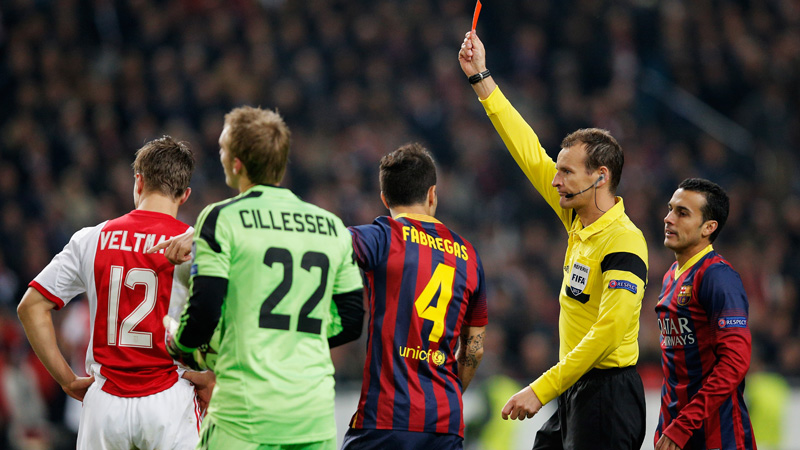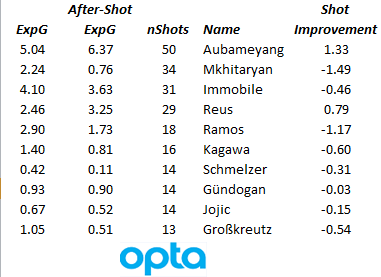This week UEFA revealed plans to make a case for an end to the ‘triple punishment’ of a penalty, a red card and a suspension for denying an obvious goal-scoring opportunity in the 18-yard box. It’s true that this punishment often seems harsh on first glance, but this move by UEFA seems like a good time to try and back this up with facts.
The best way to do this is to assign an expected goals value to all of the factors that are involved, which are:
- Penalties
- Red cards
- Suspensions
- “Obvious goal-scoring opportunities” (OGSOs)
For example, we know that about three out of four penalties are scored, so we can say that a penalty is worth about 0.75 goals.
The other factors are quite a bit harder to determine though. I’ll even leave suspensions out of the equation altogether because that would require an accurate measurement of the influence of an individual player on a team’s performance. A bit too ambitious…
Obvious goal-scoring opportunities
"OGSOs" in this case are almost by definition hard to assign a value to, because we’re specifically interested in those that are denied. That means we’re trying to measure the effect of something that didn’t happen. We also know that not all OGSOs are created equal, and that nobody can even agree on an all-encompassing definition. We can, however, look at some typical OGSO-situations.
For example, there’s the classic one-on-one with the goalkeeper. We have no readily available statistics on this either, but we do have this:
“From 1977 through 1984 the NASL had a variation of the penalty shoot-out procedure for tied matches. The shoot-out started 35 yards from the goal and allowed the player 5 seconds to attempt a shot. The player could make as many moves as he wanted in a breakaway situation within the time frame.”
This crazy American experiment may turn out to be pretty useful, as this seems to be a decent simulation of a similar situation in a match. As the video below shows, five seconds is not a lot. It puts quite a bit of pressure on the attacker, not unlike having a defender on his heels. As you can see it’s not at all easy to score.
From the available historical data on the internet I’ve gathered that in these kinds of shootouts about 48% of attempts were scored. That means this kind of one-on-one OGSO has an expected goal value of 0.48.
I take it that this is the kind of situation UEFA has in mind, but of course there are also cases where it’s not merely an opportunity that is denied, but a (near-)certain goal. Think of Suarez’s infamous handball on the line to deny Ghana in the 2010 World Cup, or a keeper intentionally bringing down an attacker who only has to walk the ball into an empty net. Surely these have an expected goal value of >0.95.
Red cards
That leaves us with the factor of the red card. In theory the effect of a red card on expected goals can be measured well, but it’s a complicated matter:
- Unlike penalties and goal-scoring opportunities, the effect of a red card isn’t constant over time. A red card in the 85th minute obviously doesn’t leave the opponent much time to capitalize on the advantage, while a red card early in the match can be a huge deal.
- There’s a risk of confusing correlation and causation. Teams ship more goals after conceding a red card, but worse teams get more red cards anyway, so if the team simply has an off-day they can expect to concede more goals and more red cards.
- When counting goals after a red card, we should exclude penalties resulting from the same incident, if we want to consider both factors separately.
Mark Taylor has done some interesting work here. As he points out not only is the value of a red card not constant, it’s not even linear, since on average more goals are scored in the second half than in the first. This means that the rate at which the value of a red card degrades increases a little as the match goes on. I’ve confirmed that this is true even if matches with red cards themselves are excluded (which would be one explanation for this effect).
Mark comes up with an expected goal value of 1.45 for a theoretical first minute red card, but because I’m not entirely sure how he got there (and because double-checking is simply good science) I decided to take a shot at it myself.
I've taken minute-by-minute data from 4.5 Premier League seasons and looked specifically at the 204 matches in which exactly one red card was given. For these matches I've taken the average number of goals scored by the 11-man team and the 10-man team, both before and after the red card was given.
After adjusting for the fact that the average dismissal is after 66% of the match, taking into account that more goals are scored near the end, and subtracting the value of penalties given for the same incident as the red card (12% of cases), I get a value of 1.08 goals for a red card in the first minute. In this theoretical case in which they still have to play the entire match the 11-man team can expect to score 0.61 goals more, and the 10-man team will have to do with 0.47 goals less.
If I exclude matches with red cards given before 20%, or after 80% of the match has been played (cases which provide too little information to compare events before and after the red card), I still end up with the same number of 1.08.
The Ole Gunnar Solskjaer guide to taking one for the team
Is UEFA right? Well, the graph shows that the combination of a red card and a penalty can be almost four times as valuable as the goal-scoring opportunity that was denied. Harsh indeed! On average it will be about 2.5 times as valuable as a one-on-one situation. This has the nasty effect of making it very tempting for the attacker to go down easily instead of staying on his feet and taking the shot.
This also serves as a handy guide for defenders. When they’re chasing an attacker who is through on goal I suggest they refer to these simple rules that they will now surely keep hidden in their sock before deciding on how to proceed:
- As long as you still run the risk of getting both a red card and a penalty, it’s never a good idea to make a foul inside the area…
- …Unless you are avoiding a near certain goal and it’s during the last minutes of the match (Suarez did the right thing).
- If he’s still outside the box and at least an hour has been played, go ahead and take him out (the Solskjaer special seen below).
- If UEFA’s suggested change goes through and you’re still in the first quarter of the match, let him enter the area and then take him out. You’re better off with a penalty than a red card.
- Under the new rules, a near-certain goal should be stopped by any means in almost all cases.
The last point makes clear that in reality a distinction would have to be made between DOGSOs and the denial of near-certain goals (DNCG?) and that the triple punishment would still have to apply to the latter. I feel that on average this new rule would be more fair, but I’m afraid that in specific cases there would be even more room for controversy.

